
DIY Herbal Outlander Salve
In the Outlander series, a WWII combat nurse called Claire, who travels back in time to 1743, must apply her 20th century medical knowledge while at the same time, she must often make-do with what is on hand or in season. She learns about folk medicine and puts them to good use; a plantain ointment for infections, a thyme and comfrey wound dressing, a yarrow disinfectant, a peppermint extract to aid digestion, an aloe vera gel for burns and an array of soothing salves.
The author, Diana Gabaldon, owns 109 books just on herbal and folk medicine alone, which she uses to highlight both the genuine medicinal properties of certain plants, as well as the slightly more humorous mythological uses, for example, the belief that Betony (Stachys officinalis) can turn toads into pigeons, and bloodwort (Sanguinaria canadensis) causes warts.
The popularity of the books and TV series has seen a renewed interest in DIY herbal remedies and below you can find a basic recipe for making your own Outlander salve.
What is an Outlander Salve?
An Outlander salve is not necessarily a strict list of herbs and ingredients that you have to rush out to find or purchase. It’s more of a concept: to look around your own environment and use the natural resources that are available there and then to treat which ever ailment is troubling you. A little bit of research and you will find that you have an entire apothecary surrounding you; grasses, herbs, shrubs, trees and even weeds all have their uses.
Essentially, an Outlander salve depends on where you live and the season. Someone living in China will have ready access to plants such as ginseng, gingko and dong quai (Angelica sinensis). People in India are surrounded by frankincense, ashwagandha, turmeric and adhatoda (Justicia adhatoda). Most Europeans only have to wander to a nearby river or lake to find nettles and mallow growing under willow and poplar.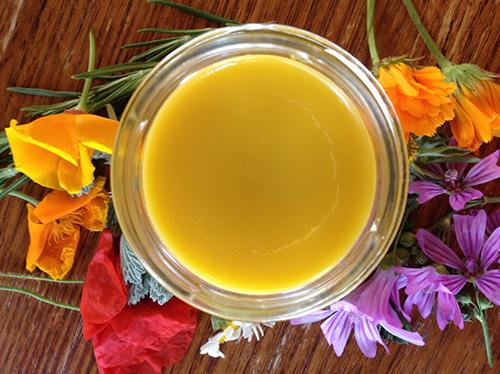
Therefore, the fundamental idea of an Outlander salve is to harvest what you can find around you, dry it for a couple of days (2 days for fine leaves, 4 – 5 days for chunky flowers and stems whereas a week for bark and roots) and then infuse your harvest in some plant-based oil to extract the oil soluble compounds. This infused oil can eventually be mixed with some beeswax to make a smooth salve with all the medicinal benefits of the plants you were able to find.
TIP: If plant identification is not your strong point, then The Forager’s Guide to Wild Foods and a smartphone app “Pl@ntNet” are a great starting point.
My Springtime Outlander Salve
STEP 1: Harvest. Within a 5-minute walk around my garden I was able to collect 14 different types of herbs for my Outlander salve (and that number would have easily doubled if I had considered bark and roots, but today I wanted to focus on spring flowering).
My list from today’s harvest includes calendula, chamomile, thyme, red poppy, mint, Californian poppy, rosemary, mallow, spiny fleabane, wooly thyme, sage, white horehound, geranium and cranes bill geranium.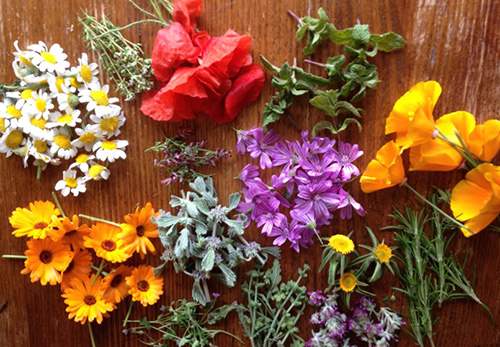
Related: Get Your Own Calendula and California Poppy Seeds, Last 30 Packs Left!
Experience and research has shown me that as long as the plant isn’t toxic, then the compounds found in many herbs act as good, general anti-oxidants, anti-microbials, anti-inflammatories and even pain relievers. And even better, many of these compounds are oil soluble such as essential oils, alkamides, fatty acids, phytosterols, terpenoids, resins… the list goes on and on.
STEP 2: Dry. The next step is to let your harvest dry at room temperature, out of direct sunlight for a few days (in my case, I had to slice some of the larger flowers in half to speed up the process to 4 days).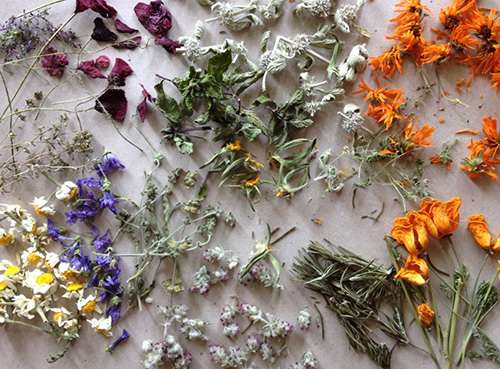
STEP 3: Infuse. When it comes to infusing your dried herbs in oil, the length of time will depend on your method; SOLAR vs DOUBLE BOILER.
THE SOLAR METHOD is a zero-energy method that takes around 4 weeks. Its usage is limited to sunny climates since this method uses the sun to heat up the oil. It is also limited to compounds that are UV stable, which excludes vitamin A and folic acid. For this method, it is essential that the oil is always covering the plant matter during these 4 weeks.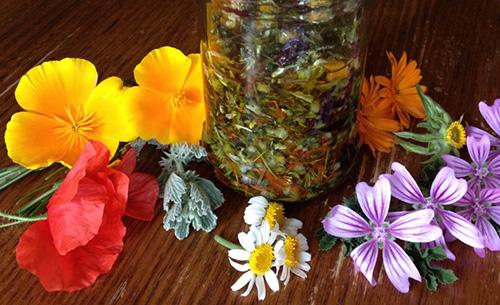
THE DOUBLE BOILER METHOD is quick and simply involves placing your glass of dried herbs and oil in a pot of warm water for at least 2 hours and up to 6 hours depending on how coarse your plant material is. The ideal temperature for most medicinal infusions is 100 °F or 37 °C. As you can see in the photo below, this method isn’t as strict about all of the plant matter being perfectly submerged since there is little risk of contamination within this short timeframe.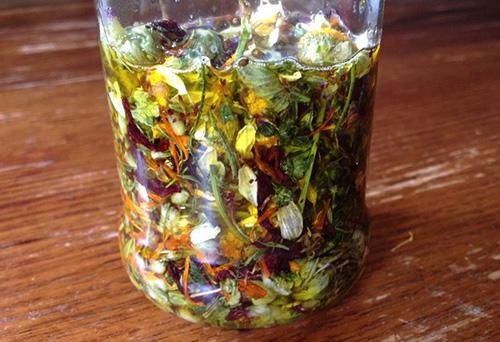
I used equal parts of olive oil, shea butter, cocoa butter, coconut butter and soy oil until all of the dried herbs in my glass jar were submerged in the oil.
STEP 4: Strain. The oil-soluble medicinal compounds have now been infused into your oil, so now it’s just a matter of straining away the plant material so that you are left with the oil.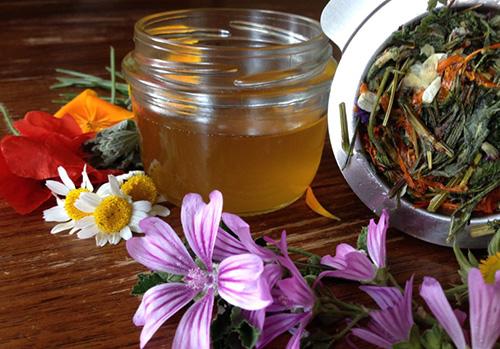
I recommend weighing how much oil you plan to use for the salve so that you know approximately how much beeswax to add next.
STEP 5: Melt. Place your glass jar in a double boiler and briefly increase the temperature of the water to 150 °F (65 °C) so that you can melt the beeswax in it. 1-part beeswax to 6-parts infused oil ratio should give you a soft texture. I ended up with 2.1 oz (60 g) of oil, so I added 0.3 oz (10 g) of beeswax.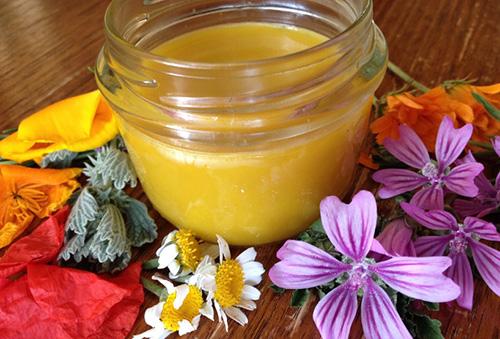
Related: Joint & Movement (Arthritis) Calendula Salve (Learn More)
Usage and Storage
Use as needed, in needed places.
As long as you have dried your plants before placing them in you oil, then this salve and the infused oil should last for at least a year.
So, while spring is still in the air (and even if it’s not….) then why not enjoy the outdoors with a little stroll around the garden, neighborhood or local park to harvest yourself some natural resources and try your hand at making your own Outlander salve.
You may also like:
 Forage These Spring Edibles Before They’re All Gone
Forage These Spring Edibles Before They’re All Gone
100+ Ingenious Projects That You May Be Missing from Your Backyard (Video)
Ramps: The Most Delicious Signs of Spring
The Best Flowers to Attract Beneficial Insects to Your Garden

You are the best! My friend and I love everything you do and say, and we love your books also.
Thank you, I will defineately find these flowers and make my own sav
Lovely! Tomorrow is my day of so off I will go to forest these or other herbs, thnx for the instruction!
What kind of oils are you using to make this?